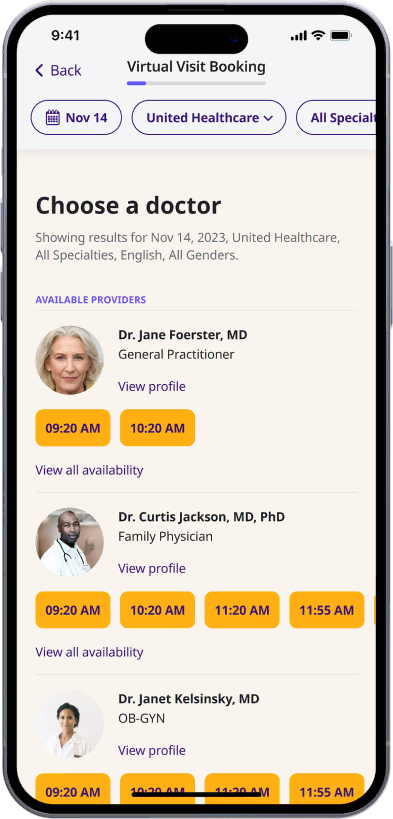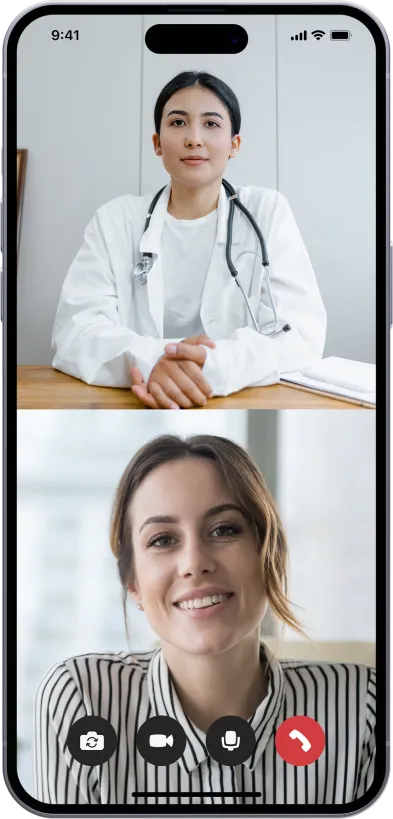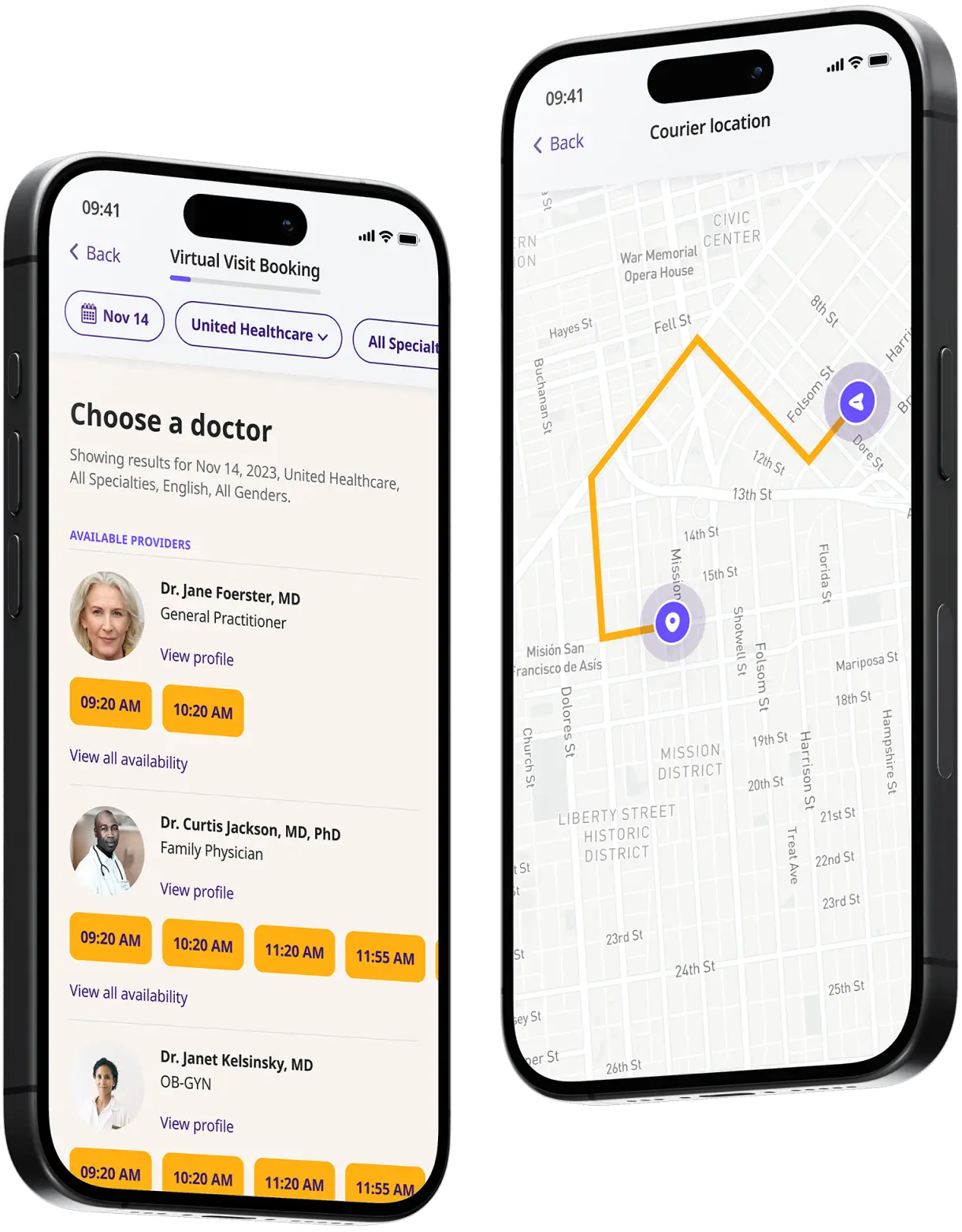Get a Fluocinolone Prescription Online
Ease skin inflammation and discomfort with fluocinolone. Get a prescription online with 24/7 access to virtual doctors.


Available in 50 states. Insurance accepted.
Fast
virtual visits
24/7 care
assistants
Prescriptions
as needed

24/7 Personal Care
Consult with a physician in 15 minutes, refill an Rx or chat with our care assistants.

Affordable & Convenient
See your cost upfront and get treatment for hundreds of different conditions.

Insurance Accepted
We accept most major insurance plans, making healthcare easy and affordable.
See If Delivery Is Available Near You
Delivery Not Available
Enter your ZIP code to check if prescription delivery is available in your area and how soon your meds could arrive.
How to get started
Choose your doctor, start a virtual visit, and have your prescriptions sent to your preferred pharmacy for pickup — all in just a few easy steps.
Choose a doctor
Choose a physician by availability, specialty, ratings, and more.

Start your video visit
Connect with a doctor in minutes on a secure video call.

Get your prescription
Pick up your meds or have them delivered in as little as an hour.

Available in 50 states. Insurance accepted.
One-Time
Physician Visit
One-time visit with a physician for diagnosis, treatment, Rx, labs, referrals, and doctor’s notes.
Accepted Insurances
See why people turn to DrHouse...
As seen in

Fluocinolone
Fluocinolone is a synthetic corticosteroid used topically to treat various skin conditions. It belongs to the class of topical corticosteroids and it is designed to reduce inflammation and alleviate symptoms such as itching, dryness, crusting, redness, swelling, and discomfort associated with skin disorders.
Fluocinolone works by inhibiting the release of substances in the body that cause inflammation. When applied to the skin, it activates natural substances in the skin to reduce swelling, redness, and itching. It is important to note that while fluocinolone can control symptoms, it is not a cure for underlying skin conditions.
Fluocinolone is a versatile corticosteroid available in various forms, catering to different medical needs. It is primarily used as a topical cream, ointment, or lotion for skin conditions such as eczema, psoriasis, and dermatitis.
In addition to its topical application for skin conditions, it is also available as an otic (for the ear) and ophthalmic (for the eye) formulation, each designed for specific treatments.
Otic Form: Fluocinolone acetonide, in its otic form, is used to treat ear conditions. It is often formulated as an ear drop and is used to reduce inflammation and discomfort caused by certain ear diseases. These conditions may include eczema or psoriasis affecting the ear, or specific types of ear infections where an anti-inflammatory is needed alongside other treatments.
Ophthalmic Form: The ophthalmic form of fluocinolone is used in the eyes. It’s typically prescribed for treating certain eye conditions that cause inflammation, like uveitis or iritis. This form can be in the form of eye drops or as an implant that slowly releases the medication inside the eye. It’s crucial to use this form of fluocinolone strictly under the guidance of an ophthalmologist, as improper use can lead to serious eye complications.
In the United States, fluocinolone is available under the following brand names:
- Topical: Capex, Synalar.
- Ophthalmic: Iluvien, Retisert, Yutiq.
- Otic: DermOtic, Flac.
Common side effects associated with fluocinolone may include:
- Mild burning, itching, drying, or irritation of the treated area
- Changes in skin color
- Increased hair growth
- Mild rash or pimples
More serious side effects which should be reported to your healthcare provider immediately may include:
- Severe rash or hives
- Difficulty breathing or swallowing
- Wheezing
- Severe irritation of the treated area
- Signs of an inception in the treated area
The above lists of possible side effects associated with fluocinolone are not exhaustive and other side effects may occur. If you experience any severe or persistent side effects while taking fluocinolone, it is important to contact your healthcare provider right away.
Frequently Asked Questions About Fluocinolone
What Is Fluocinolone Used to Treat?
Depending on the form, fluocinolone is used to treat various skin conditions, ear infections, and ear diseases, as well as certain eye conditions that cause inflammation.
In topical form, it is commonly used to treat skin disorders like eczema, psoriasis, and dermatitis. In addition, otic form is used for ear conditions such as eczema or psoriasis affecting the ear, or specific types of ear infections where an anti-inflammatory is needed alongside other treatments. The ophthalmic form is primarily prescribed for eye conditions that cause swellings.
What Are the Most Common Side Effects of Fluocinolone?
The most common side effects of Fluocinolone involve various forms of mild irritation at the site where the medication was applied. This can include symptoms such as redness, itching, burning, or drying of the skin. These side effects are generally mild and often resolve on their own over time. However, if any of these symptoms persist or worsen, it is important to contact a healthcare provider for further guidance.
What Is the Typical Starting Dose of Fluocinolone?
The starting dose of fluocinolone will vary depending on both the form of the medication and the condition being treated. For topical use, a thin layer of cream or ointment is usually applied to the affected area 2-3 times daily.
It’s important to follow the specific instructions provided by the healthcare provider and not to use more than prescribed, as this can increase the risk of side effects.
How to Use Fluocinolone?
When using fluocinolone it’s important to follow the directions provided by the healthcare provider and use it only as prescribed. Some general tips for taking fluocinolone include:
For topical use:
- Fluocinolone should be applied to clean, dry skin.
- It’s important to avoid getting the medication in your eyes, nose, or mouth.
- Wash your hands thoroughly after each application to prevent unintended ingestion.
- Do not use coverings unless specifically instructed by your healthcare provider.
- Apply a thin layer of medication and rub it in gently, being careful not to irritate the skin further.
For otic use:
- Ensure your hands are clean before handling the medication.
- Tilt your head to one side so that the ear that requires treatment is facing upwards.
- Gently pull the earlobe up and back to straighten the ear canal, making it easier for the drops to reach deeply.
- Apply the prescribed number of drops into the ear without letting the dropper touch your ear to avoid contamination.
- Keep your head tilted for a few minutes to allow the medication to penetrate deeply into the ear.
- Use a small piece of cotton to prevent the medication from leaking out if instructed by your healthcare provider.
For ophthalmic use, follow the specific directions provided by your healthcare provider.
Can Fluocinolone Be Used During Pregnancy or While Breastfeeding?
The use of fluocinolone during pregnancy or while breastfeeding should be discussed with a healthcare provider. While there is limited research on the effects of fluocinolone during pregnancy and breastfeeding, it is important to weigh the potential benefits against any risks for both the mother and baby.
In general, topical forms of corticosteroids are considered safe to use during pregnancy. However, this depends on the potency of the medication.
Breastfeeding mothers need to exercise caution when using topical corticosteroids like fluocinolone. Although the manufacturer suggests that these medications are generally safe for breastfeeding patients, it’s essential to consult a healthcare provider. This is because systemic corticosteroids, which affect the entire body rather than a specific area, can be present in breast milk and may pose risks to the nursing infant.
Do You Need a Prescription for Fluocinolone?
Yes, fluocinolone requires a prescription from a healthcare provider. This is because the medication can have potential side effects if not used properly, and it’s important for a healthcare professional to monitor its use.
Can You Get an Online Prescription for Fluocinolone From DrHouse?
Yes, if deemed appropriate by a doctor or healthcare provider, you can receive an online prescription for fluocinolone from DrHouse.
Our platform connects patients with healthcare professionals who can evaluate your condition virtually and prescribe medication and medication refills as needed.
For more detailed information about fluocinolone, you can refer to the following sources:
Related services
Explore more of our services tailored to your needs and discover additional ways we can support your healthcare needs.
Frequently asked questions




